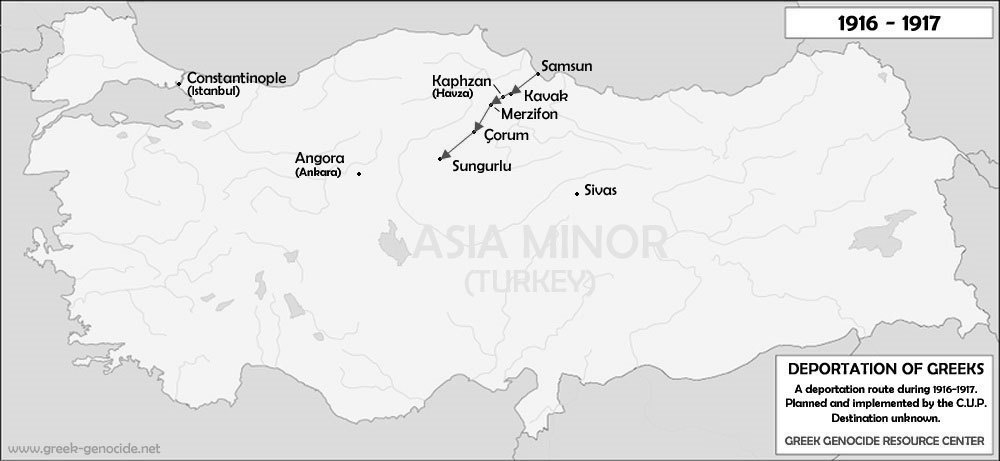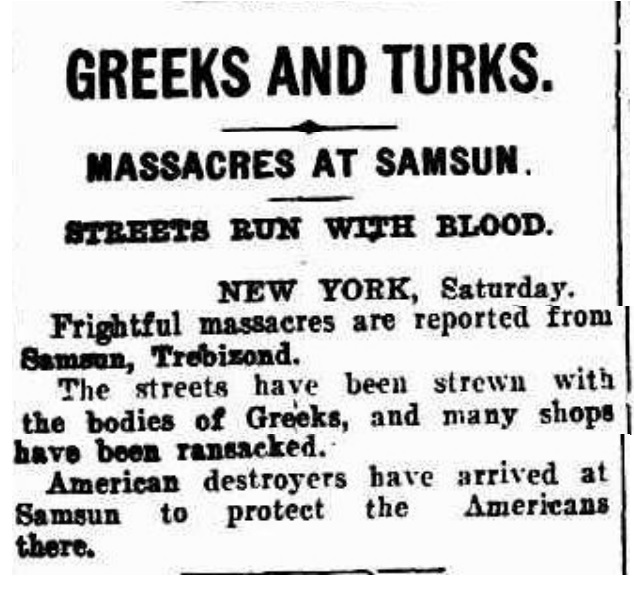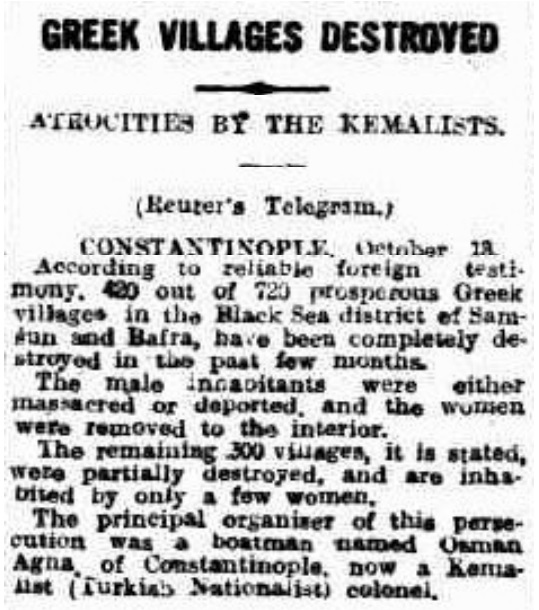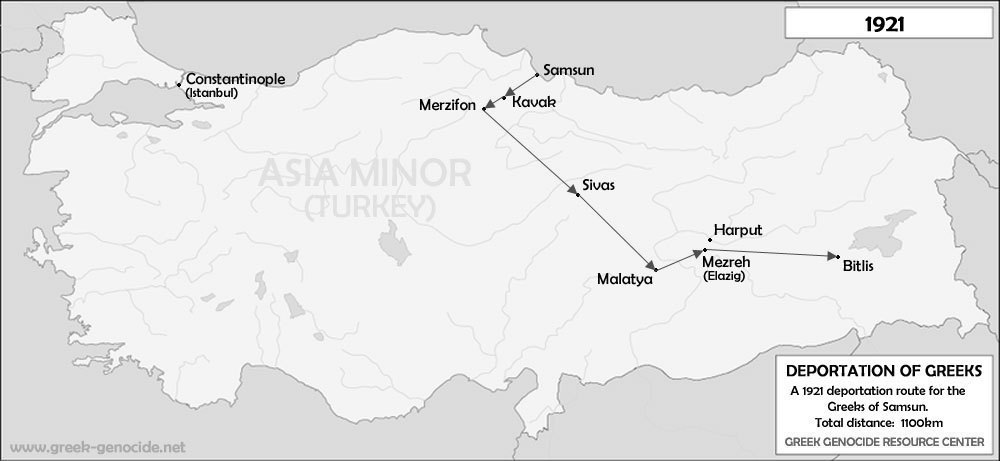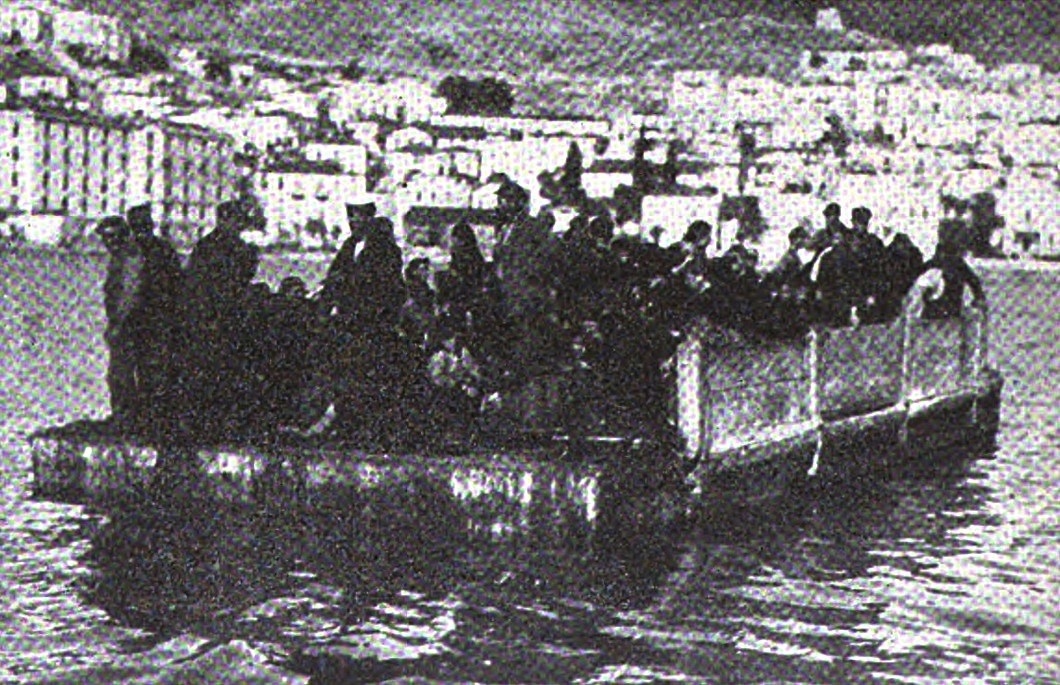A 1916 deportation route for the Greeks of Samsun.
Samsun (Gr: Σαμψούντα) is a city located in northern Turkey along the Black Sea shoreline. During the Greek Genocide, Greeks from Samsun and the surrounding district were deported in three waves: in 1916/17, 1921 and finally in 1922. Before these deportations, Greeks in the region numbered approximately 80,000 and made up about 65% of the total population.1
Having earlier deported Greeks from eastern Thrace and regions along the western coastline of Asia Minor, in 1916 the CUP (Committee of Union and Progress Party) turned its focus on the Greeks living in communities along the Black Sea coastline. These deportations were on the grounds of military necessity but were lethal and coincided with burning and looting of property.
Persecution under the C.U.P (1916-1917)
The first deportations occurred in late 1916 to early 1917. A report by the Greek legation at Constantinople dated December 27, 1916 stated how the city of Samsun was encircled by the Turkish army and people were ordered to the city center. These people (including women, men and women who had just given birth to babies and the babies themselves) were imprisoned in barracks. They were then led out to snow covered mountains. Following the deportations, the homes of the deportees were raided and their belongings taken and sold. While the final destination was unknown, the deportees were seen in Kavak (47km from Samsun) on the first night where they buried their dead. They were then taken to Kafzan [Havza] in the district of Sivas (80km from Samsun) then to Çorum (168km from Samsun).2
The deportation resumed on January 17 and 18 [1917] and this time included Greeks from Bafra. As of the 15th of January, 28 villages had been burned excluding those from December. Deportation of women and children by foot and in the midst of rain and snow continued from Samsun to the provinces of Angora and Sivas. The sick and the old were pushed from place to place many sleeping out in the cold naked. Many died of starvation and disease. The number deported was estimated at 20,000. The Greeks of Giresun were also deported during this period.
The two main perpetrators of the deportations and the burning of villages in Samsun were Rafet Pasha and Vehaedin. Vehaedin was a special official of the Ministry of the Interior. He had arrived in the Samsun district around the time of the deportations from Constantinople. He was responsible for preparing the lists of the persons to be deported. Rafet Pasha was a member of the CUP and an emissary of the Ministry of War. He was described as being fanatic, passionate and a hater of Greeks. He was responsible for carrying out the deportations and also arson.3
The Austrian Ambassador of Constantinople Johann Markgraf von Pallavacini described the events around Samsun during December 1916 as follows:
11 December 1916: Five Greek villages were pillaged and then burnt. Their inhabitants were deported. 12 December 1916: In the outskirts of the city more villages are burnt. 14 December 1916: Entire villages including schools and the churches are set on fire. 17 December 1916: In the district of Samsun they burnt eleven villages. The pillaging continues. The village inhabitants are ill-treated. 31 December 1916: Approximately 18 villages were completely burnt down, 15 partially. Around 60 women were raped. Even churches are plundered.4
On 20 January 1917, Ambassador Pallavicini alerted his superiors in Vienna about the condition of the deportees and compared them to the Armenian deportations a couple of years prior:
The situation of the deported is for despair. Death awaits them all. I tried to draw the attention of the Grand Vizier to the events and stress how sad it would be if the persecution of the Greek element takes the form and dimensions of the Armenian persecutions.5
Persecution under the Kemalist Nationalists (1921)
The second deportations of Greeks from Samsun occurred in 1921 under the command of the Kemalist nationalists of Mustafa Kemal (later Atatürk). In early June of 1921, the Hellenic Navy bombarded Inebolu (270km west of Samsun) and Samsun itself. In retaliation, the Kemalists deported entire Greek communities to the interior of Turkey and destroyed their villages.
Tweed Daily (Murwillumbah, NSW) 6 Jun 1921. p3
Wilford Washburn Fuller was an American Near East Relief worker who was assigned to Harput for agricultural and transportation work. On the 4th of July 1921 he left Sivas on a Near East relief truck and witnessed five parties of Greek men being deported from Samsun through Sivas headed for the interior. Of the first two parties numbering 900, Fuller stated that only 200 arrived at Sivas, naked, robbed, sun blistered, the gold having been forced out of their teeth. Those who survived reported that the others had been massacred at Kavak. Fuller also witnessed 3,000 Greek women and children under Turkish guard along a road between Amasia and Marsovan.6
On the 10th of July 1921, New York Times reported on the deportation of 800 Greek clerks and 1,500 Greek civilians to the interior while the population of 30 other villages of Samsun were massacred as they were being deported. The massacre was so fierce that Turkish authorities prohibited the use of river waters due to the contamination by the bodies of those massacred.7
On the 21st of October 1921 a news report in the South Australian Daily Herald (pictured below) stated that 420 of 720 Greek villages in the Samsun and Bafra districts had been completely destroyed. The male inhabitants had either been massacred or deported and the women were sent to the interior.8
Daily Herald (Adelaide, SA) 21 Oct 1921, p5.
In 1921, while doing transportation duties for the Near East Relief, Stanley E. Hopkins witnessed the deportation of Greeks during trips he made between Harput and Samsun. On the 1st of September 1921, Hopkins started on a trip by automobile from Harput en route to Samsum and on the roads he passed a number of Greeks being deported from the coast of the Black Sea to the east. He estimated there were 12,000 people. After leaving Samsun on his return to Harput, Hopkins passed elderly Greek men being deported. In describing their plight, Hopkins recounted:
There was no food allowance for them, and any food that they could obtain had to be procured by money or sale of small articles that they could carry with them. On the trip I passed many corpses of Greeks lying by the road side where they had died from exposure. Many of these were the corpses of women and girls with their faces toward the sky, covered with flies.
On the 1st of October, Hopkins once again started form Harput to Samsun this time accompanied by Near East Relief workers Miss Miriam Bailey and Miss Margaret McClellan. On this trip they passed 10,000 Greeks. One of the groups numbering 2,000 was entirely of women, most of them with no shoes and many carrying babies on their backs and in their arms.
On his last trip out from Harput, Hopkins witnessed more people being deported and came to the conclusion that Harput was the gathering place for the Greek deportees before they were sent further east. He wrote:
There are between fifteen and twenty thousand Greeks in Harput from all regions to the west and north. They are absolutely without help, and in the nature of the case large numbers of them are dying. They are allowed to stay in Harput a short time and are then sent forward to the east where their fate is not known.
A 1921 deportation route for the Greeks of Samsun.
As noted by Hopkins, the deportation of Greeks to the interior during that period was not isolated to the Black Sea Greeks. Many Greeks from western Asia Minor and other regions were also deported to the interior. Hopkins declared:
The deportation of Greeks is not limited to the Black Sea Coast but is being carried out throughout the whole country governed by the Nationalists.
Others who were present in Asia Minor during the deportations include Lieutenant Arthur David Murray of the USS Overton, who stated in his testimony dated 28 August 1921 while stationed in the Black Sea, that:
2,500 girls taken from various villages who were deported, they had been so badly dealt with they could hardly walk. In all there were five parties of deportees. The first and second parties, numbering 900, came from Samsun, but of these only 200 arrived safely at Sivas, clothes torn, some entirely naked. They had been robbed even of the filling in their teeth.9
Edith L. Wood a Near East Relief worker witnessed the deportations and stated that on the road from Samsun to Harput, “bodies lay along the roadside and in the fields everywhere. There was no hope for the Greeks from Malatia to Samsun, and the most fortunate were those who perished at the start.” 10
The deportations from Samsun resumed in 1922. In April 1922, Commander Webb Tramell of USS Fox reported that 1,300 Greek women, children and old men were being sent out from Samsun.11 During the 15th of May 1922 session of Parliament in the British House of Commons, Arthur Nevile Chamberlain spoke of the deportation of Greeks from the Black Sea coastline. Chamberlain referred to two official reports telegraphed on the 10th of May 1922 by Horace Rumbold, Britain's High Commissioner at Constantinople as well as the witness account of American Relief worker Forrest D. Yowell. Chamberlain stated:
The Turks appear to be working on a deliberate plan to get rid of minorities. Their method has been to collect at Amasia, Ottoman Greeks from region between Samsoun and Trebizond. These Greeks are marched from Amasia via Tokat and Sivas as far as Ceasarea, and then back again until they are eventually sent through Khar-put to the east. In this manner a large number of deportees die on the road from hardship and exposure.12
Mark H. Ward was a Near East Relief physician who was deported from Turkey for keeping notes on the deportations and administering relief to the deportees. While in Harput during 1921-22, Ward witnessed and kept a tally of 20,378 deportees who streamed in to the town from all over Asia Minor. Ward stated that 18,000 of these deportees were Ottoman Greeks. Some of the deportees were from Samsun. Reports of thousands dieing by the roadside during the deportations indicates that the initial number was much higher than the number that reached Harput. Ward was to state that from Harput, the deportees were then marched south towards Diarbekir and then into the Vilayet of Bitlis.13
Greeks being evacuated to safety, Samsun c.1923. Following their march to the port of Samsun on the Black Sea coast, genocide survivors are loaded onto barges to be towed out to ships which will transport them to Constantinople, and eventually Greece. Source: The New Near East, Apr 1923, 14.
1. Leon Maccas, L'hellénisme de l'Asie-Mineure. Berger-Levrault, Paris 1919, 83.
2. Persecution of Greeks in Turkey since the Beginning of the European War. American Hellenic Society, New York, 1918. 48-55
3. Ibid., 52-53.
4. Wien Haus-, Hof- und Staatsarchiv, PA, Türkei XII, Liasse 467 LIV, Griechenverfolgungen in der Türkei 1916- 1918, ZI. 97/pol., Konstantinopel (19.1.1916), (2.1.1917).
5. Wien Haus-, Hof- und Staatsarchiv, PA, Türkei XII, Liasse 467 LIV, Nr.6/P., Konstantinopel (20.1.1917)
6. Black Sea: A Naval Officer's Near East Experience, ed Renee Heideman. Kindle edition, p640/853.
7. 700,000 Greeks Victims of Turks, The New York Times. July 10, 192, 4.
8. Greek Villages Destroyed, The Daily Herald. South Australia, October 21, 1921, 5.
9. Arthur Murray, Black Sea: A Naval Officer’s Near East Experience. Kindle, p660 of 853
10. Robert Shenk, America’s Black Sea Fleet, Naval Institute Press, 116.
11. Ibid., 110.
12. UK Parliament, House of Commons Hansard. Accessed online on 4/12/2019 at https://hansard.parliament.uk/Commons/1922-05-15/debates/
13. The Deportations in Asia Minor, Anglo-Hellenic League. London 1922, 4.
Last edited: 4 Dec 2019
Further Reading:
Black Book: The Tragedy of Pontus, 1914-1922
6 Nov 1921: Reports Massacres of Greeks in Pontus, New York Times
Pontus
The Greek Genocide in American Naval War Diaries
Feridunoğlu Osman Ağa (1883-1923)

